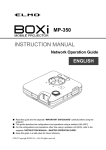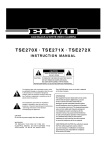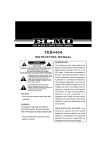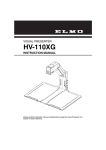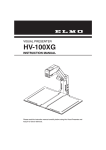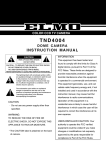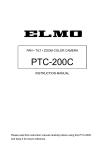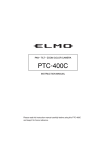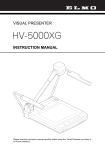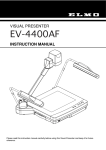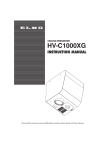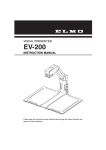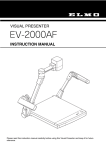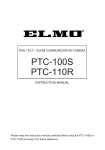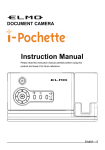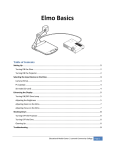Download Elmo QNW4000 Instruction manual
Transcript
QNW4000 INSTRUCTION MANUAL CAUTION RISK OF ELECTRIC SHOCK DO NOT OPEN CAUTION : TO REDUCE THE RISK OF ELECTRIC SHOCK. DO NOT REMOVE COVER (OR BACK). NO USER SERVICEABLE PARTS INSIDE. REFER SERVICING TO QUALIFIED SERVICE PERSONNEL. The lightning flash with arrowhead symbol, within an equilateral triangle, is intended to alert the user to the presence of uninsulated "dangerous voltage" within the product's enclosure that may be of sufficient magnitude to constitute a risk of electric shock to persons. The exclamation point within an equilateral triangle is intended to alert the user to the presence of important operating and maintenance (servicing) instructions in the literature accompanying the appliance. CAUTION . Do not use any power supply other than specified. INFORMATION This equipment has been tested and found to comply with the limits for Class A digital device, pursuant to Part 15 of the FCC Rules. These limits are designed to provide reasonable protection against harmful interference when the equipment is operated in a commercial environment. This equipment generates, use, and can radiate radio frequency energy and, if not installed and used in accordance with the instruction manual, may cause harmful interference to radio communications. Operation of this equipment in a residential area is likely to cause harmful interference in which case the user will be required to correct the interference at his own expense. WARNING TO REDUCE THE RISK OF FIRE OR ELECTRIC SHOCK, DO NOT EXPOSE THIS APPLIANCE TO RAIN OR MOISTURE. * The CAUTION label is attached on the bottom of camera. USER-INSTALLER CAUTION: Your authority to operate this FCC verified equipment could be voided if you make changes or modifications not expressly approved by the party responsible for compliance to Part of the FCC Rules. IMPORTANT SAFETY INSTRUCTIONS 1. Read these instructions. 2. Keep these instructions. 3. Heed all warnings. 4. Follow all instructions. 5. Do not use this apparatus near water. 6. Clean only with dry cloth. 7. Do not block any ventilation openings, install in accordance with the manufacture's instructions. 8. Do not install near heat sources such a radiators, heat registers, stoves or other apparatus (including amplifiers) that produce heat. 9. Only use attachment/accessories specified by the manufacturer. 10. Unplug this apparatus during lighting storms or when unused for long periods of time. 11. Refer all servicing to qualified personnel. Servicing is required when the apparatus has been damaged in any way, such as power-supply cord or plug is damaged, liquid has been spilled or objects have been fallen onto the apparatus, the apparatus has been exposed to rain or moisture, does not operate normally, or has been dropped. -1- Housing Protection Indoor Outdoor but under roof or eaves Outdoor not under roof or eaves Height or blowing place like steel tower (Shading cover required) Caution: - Do not install this camera at sea, at coast or in coastal area or at any corrosive gas generating place. - Since it is not of totally weatherproof specifications, do not install this camera at any weather-beaten place. When it is used mounted with the shade for outdoor use (SS-20), the weatherproof specifications meet the requirements of IP54 (Conformable to IEC/EN 60529). This camera may be installed outdoors but with restrictions; do not install this camera at any place open to gusty wind and rain as seen in typhoon (e.g., high steel tower), to snow (e.g., cold district), to water spray (e.g., coast or coastal area), or to water (e.g., under the water). For further information of installation place, consult our dealer. -2- PART NAMES AND FUNCTIONS 84 (3.3) 45 (1.8) 14 (0.6) 230 (9.1) 75 (3.0) 84 (3.3 ) 84 (3.3) 45 (1.8) 14 (0.6) All dimensions in mm (inch) Front glass Tripod fixing tapped holes (1/4-20UNC) These tapped holes are used to fix the camera on the tripod and mount the shade (optional) on the camera. The tapped holes for fixing the tripod are provided at 2 locations in the top and bottom surface of the camera. Each tapped hole is 5mm deep. Weatherproof cap -3- INT/LL switch INT (internal) control switch When the internal synchronization is used, set the switch to the INT side. LL (Line-Lock) control switch Matching the vertical synchronization with the power frequency is called the line-lock. When two or more cameras are switched by the video switcher to a monitor TV, the vertical sync. phase can be locked with the power frequency, and a stable vertical sync. is obtained without being disturbed at the time of switching. Line-lock is operative only when the AC 24V power supply is connected. Caution: 1. The camera is synchronized to the power frequency of 60Hz 0.5Hz covering a normal fluctuation of the power frequency. The camera may not compensate for large fluctuation caused by power generated by an engine generator. etc. 2. It takes about 10 seconds or more to obtain a stable synchronization after the power is turned on. This is necessary to stabilize the camera against the power noise. BLC (Back Light Control) switch In case the back lighting is too bright to shoot the main object clearly, set this switch to ON position. -4- SENS-UP switch To increase the sensitivity, set this switch to ON position. DAY/NIGHT switch When the DAY/NIGHT function is used, this switch is turned ON. (See P. 9.) Camera output terminal This is an image output terminal. When the camera direction, the field angle or the focal point is adjusted, a monitor TV or other type display is connected to this terminal. When a monitor TV is connected to this terminal, remove the 2P connector beforehand. Level adjusting volume This volume is used to adjust the brightness of the image. If the lens iris is not appropriate, adjust the iris with this level adjusting volume. Vertical sync. phase adjustment potentiometer Vertical sync. phase adjusting potentiometer is set at the position fully that the delay time of vertical sync. phase against the phase of power frequency is shortest, when shipped from the factory. Select this up ( ) and down ( ) button will make the delay time of vertical sync. phase against the phase of power frequency longer. Use the function control potentiometer if the picture image on a monitor TV may flow when using the camera in combination with other camera(s) controlled by the Line-Lock synchronization. In this case, get a proper image by shifting the phase of vertical sync. signal of the camera against that of the other. If a proper image cannot be obtained even after this adjustment, reset the potentiometer to its original position, and use the function control potentiometer of the other camera to shift the phase of vertical sync. signal of other camera. Caution: Before making adjustment, make sure that cameras have their power supplies connected with the same polarity. (not 180 apart) -5- Coaxial core clamp This clamp fixes the cores of the coaxial cable. Coaxial cable clamp This clamp fixes the sheath of the coaxial cable. Ground terminal This is a supplementary ground terminal. AC power terminal Connect this to the AC24V 60Hz power supply. Earth terminal Connect this to the ground wire of the power supply cord. -6- HOW TO CONNECT 1. Remove the rear cover, the GND cable, and the two 2P connectors. 2. Connect the coaxial cable and the power cable. After connecting the power cable on the terminal block, be sure to mount the protective cover. Caution: Fasten the weatherproof cap firmly, and make sure that the cable is fixed completely. If the cap is not fastened firmly, water leak may be caused. (The appropriate tightening torque: 4.0~4.5N.m) When connecting the coaxial cable, be sure to remove the 2P connectors. 3. Connect the two 2P connectors and the GND cable. After connecting the connectors and the cable, mount the rear cover. Caution: The rear cover has a weatherproof seal. Before mounting the rear cover, make sure that the seal is set in the groove in the rear cover. If the setting of the seal is not sufficient, water leak may be caused. When mounting the rear cover, be careful not to pinch the two 2P connectors or the GND cable. Be sure to connect the ground wire of the power cable to the earth terminal . Do not use the power cable of flat type, which does not fit the weatherproof cap. For the power cable, use one attached with a force-fit 5.7 terminal. If the force-fit portion of the force-fit terminal is protruded from the terminal block, insulate the force-fit portion. 2P connector force-fit terminal force-fit portion Terminal block 2P connector (with protective cover) Coaxial core clamp Rear cover Coaxial cable clamp Seal Weatherproof cap GND cable Power cable (GND) Coaxial cable Power cable -7- Applicable cable diameter: 5.0~10.0mm LENS 1. Built-in Lens This camera is built in with a dedicated varifocal lens. F: 1.4 f: 2.8mm~5.8mm 2. Lens adjustment Adjust the field angle of the lens with the zoom ring, and set the focus with the focus ring. After setting, lock the lens firmly with the focus ring locking knob and the zoom ring locking knob. (Factory setting: WIDE end / Infinite) Adjust the iris volume, if necessary, to obtain the appropriate exposure. (See P.5 .) Caution: When adjusting the iris of the auto iris lens, open the iris fully in the circumstance with sufficient light amount of the object beforehand. If the light amount of the object is not sufficient, a malfunction may occur. Zoom ring Focus ring Camera main unit Zoom ring locking knob Focus ring locking knob Front cover -8- Day/Night FUNCTION This camera is provided with Day/Night function that can detect the brightness of the objects and automatically switch the color mode / black-and-white mode according to the detected brightness. This function allows the output of ordinary colored images for the outdoor monitoring during daylight and the output of black-and-white images for the night monitoring with a lack of sufficient light volume. Therefore, even at night, this camera can provide monitoring through images with little noise. Furthermore, since this function raises the sensitivity in the infrared area, even a dark object can be imaged more clearly at night when a commercially available infrared lamp is used together. To make this function enabled, set the Day/Night switch on the rear panel to "ON." When the Day/Night switch is set to "OFF," the camera operates as an ordinary color camera even at night. When the Day/Night switch is set to "ON" and the object becomes gradually brighter as the time passes like dawn, it may take time to switch from the black-and-white mode to the color mode. As a result, the image taken in the early morning may be in black and white. However, note that this is not a malfunction. The Day/Night function controls the mode switching between the color mode and the black-andwhite mode according to the signal level. Since the signal level varies depending on the camera settings to shoot the object, the timing of Day/Night switching varies accordingly. When more than one screen is displayed by the controller or the like, the Day/Night mode may vary depending on the camera shooting conditions even if the brightness is the same. -9- OPTION (1) Heater glass unit Mounting method for the heater glass unit (DF-20) Connector jack in the main unit 1. Remove the front cover. 2. The removed front cover (with four screws) is not used. 3. Instead of the front cover removed in the step 2., mount the heater glass unit. 4. Insert the connector of the heater glass unit wiring into the connector jack in the main unit. 5. Mount the heater glass unit. Caution: When mounting the heater glass unit, be careful not to pinch the wiring or bring the wiring in front of the lens blocking the image. The heater glass unit has a weatherproof seal. Before mounting the heater glass unit, make sure that the seal is set in the groove in the heater glass unit. Note with care that if the setting of the seal is not sufficient, water may leak into housing. 1.2W (DC15V) Heater glass unit (DF-20) - 10 - (2) Shade (Cover for outdoor use) Mounting method for the shade (SS-20) Mount the shade (cover for outdoor use) firmly over the camera main unit with the two attached fixing bolts. Use the tripod fixing tapped holes in the top of the camera main unit. Fixing bolt Through hole for bolt Shade Tripod fixing tapped hole Camera main unit (3) Fittings For mounting on the wall mounting bracket (Outdoor specifications) Mount the camera on the wall mounting bracket using the tapped holes in the bottom of the camera and the two fixing bolts attached to the camera. Front side of the camera Caution: When the camera is installed outdoors, since its drip-proof performance degrades, do not direct the front side of the camera upward at any degrees from the level position. Wall fitting Do not install the camera upside down. Fixing bolt Fasten the fixing bolts firmly so that the camera cannot come off and drop due to looseness. Insulating spacer - 11 - For mounting on the ceiling mounting bracket (Under eaves and indoor specifications) Mount the camera on the ceiling mounting bracket using the tapped holes in the top of the camera and the two fixing bolts attached to the camera. Caution: Wall mounting bracket When the camera is installed outdoors, since its drip-proof performance degrades, do not direct the front side of the camera upward at any degrees from the level position. Front side of the camera Do not install the camera upside down. Fasten the fixing bolts firmly so that the camera cannot come off and drop due to looseness. For mounting on the ceiling mounting bracket together with the shade (SS-20) Use the fixing bolts attached to the shade. (Do not use the fixing bolts attached to the camera.) Caution: Fasten the fixing bolts firmly so that the camera cannot come off and drop due to looseness. Wall mounting bracket Front side of the camera Shade (SS-20) - 12 - TROUBLESHOOTING Symptom Image is not seen. Check point Is the iris of the lens adjusted appropriately? Are the cables connected correctly? Are the power plugs of the peripheral units inserted firmly in the outlet? Image is not colored. When Day/Night function is set to "ON" and the object is dark, the image is in black and white. Image is not colored accurately. Is the video monitor adjusted appropriately? Isn't the light dark with the Day/Night function set to "OFF"? - 13 - SPECIFICATIONS QNW4000 Model Power source AC24V 60Hz 0.5Hz Power consumption Approx. 5.0w Pick-up device 1/4" Color interline-transfer CCD Effective picture element 768 (H) X 494 (V) Scanning area 3.65mm (H) X 2.74mm (V) Scanning system 2:1 interlaced Scanning frequency LL:15.75kHz (H), 60Hz (V) / INT:15.734kHz (H), 59.94Hz (V) Sync. system Line-Lock / Internal (Factory-set at Line-Lock) Resolution 470 TV lines (H), 350 TV lines (V) S/N ratio More than 48dB Minimum illumination 1.5lx (DAY/NIGHT:OFF) 0.3lx (DAY/NIGHT:ON) AGC Built-in White balance ATW Backlight control (BLC) Provided (Factory-set at OFF) Sens-up Provided (Factory-set at OFF) Day/Night Provided (Factory-set at ON) Monitor out RCA VBS 1V (p-p) 75 Iris DC system Iris level adjustment Provided Lens 1/4" vari-focal lens F: 1.4 f: 2.8~5.8 Weatherproof specifications IP54 (When outdoor shade is used) Dimensions 84 (W) X 75 (H) X 230 (D) mm (3.3 X 3.0 X 9.1 inches) Weight 1.2kg (2.6lbs) Ambient temperature -10 ~50 Ambient humidity 30 ~ 90 Supplied accessories Instruction manual Warranty card Tripod screws (14 F~122 F) Note: Weight and dimensions are approximate. Design and specifications are subject to change without prior notice. - 14 - PRECAUTIONS FOR USE AND INSTALLATION * Never aim the camera at the sun. Never aim or point the camera at the sun even if you are not shooting. * Do not shoot intense light. Strong light such as a spot light on the image plane will cause blooming or smear. When strong light comes into the image plane, vertical stripes may appear on it. However, this does not mean that the camera is defect. * Take precautions when handling a camera. Do not drop your camera, or give it a strong shook or vibration. This may cause camera to malfunction. * Do not touch internal parts. Be sure not to touch the internal parts. This may cause to electrical shock. * Do not let the camera get wet. Install the camera at the place where it will not get wet. Should it gets wet, turn off the power immediately and contact your dealer. * Install your camera where no video noise appears. When camera cables have been laid near electric wires or television receivers, a noise may interfere the image. If noise occurs, relocate cables or reinstall equipment. * Check the ambient temperature and humidity. Avoid using camera in areas where temperature is consistently hotter or colder than the specified range (See Specifications chart below) or poor image quality or damaged parts may occur. Precautions should also be taken to avoid areas of high humidity. * Should you notice any trouble. If any trouble occurs while you are using the camera, turn off the camera and contact your dealer. Failure to do so may cause damage to the camera. * The socket-outlet should be installed near the equipment and should be easily accessible. ELMO CO., LTD. 6-14, Meizen-cho, Mizuho-ku, Nagoya, 467-8567 Japan OVERSEAS SUBSIDIARY COMPANIES ELMO Mfg. Corp. ELMO Canada Mfg. Corp. ELMO (Europe) G.m.b.H. 1478 Old Country Road, Plainview, NY 11803-5034 U.S.A. Tel. 516-501-1400 Fax. 516-501-0429 E-mail:[email protected] Web:http://www.elmousa.com 44 West Drive, Brampton, Ontario, L6T 3T6, Canada Tel. 905-453-7880 Fax. 905-453-2391 E-mail:[email protected] Neanderstr. 18 40233 Dusseldorf, Germany Tel. 0211-376051-53 Fax. 0211-376630 E-mail:[email protected] 6X1NRNA02 Printed in Japan - 15 -
















